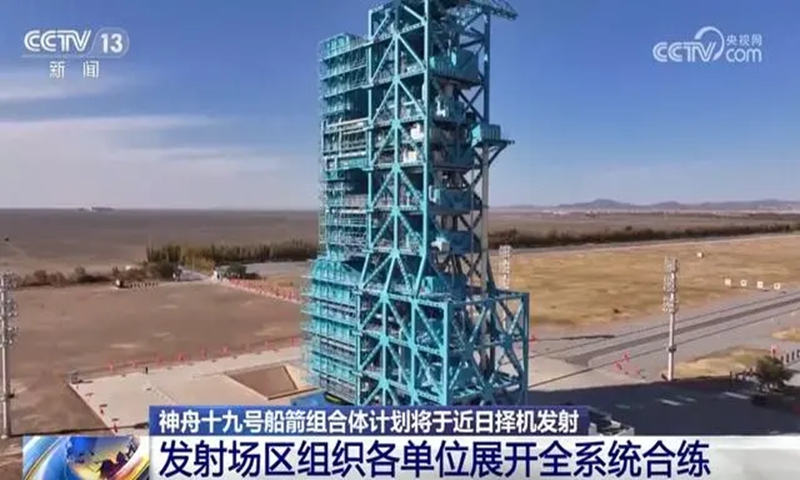
Jiuquan Satellite Launch Center in Northwest China's Gansu Province organizes the whole-process exercise for the upcoming Shenzhou-19 manned spaceflight mission to China Space Station, testing and verifying the reliability and safety for the launch mission, on October 26, 2024. Photo: CCTV
Jiuquan Satellite Launch Center in Northwest China's Gansu Province organized over the weekend the whole-process exercise for the upcoming Shenzhou-19 manned spaceflight mission to China Space Station, testing and verifying the reliability and safety for the launch mission, according to the launch center on Sunday.
The China Manned Space Agency (CMSA) announced on October 22 that the combination of Shenzhou-19 manned spacecraft and the Long March-2F Y19 rocket has been transferred to the launch pad. It is reported that the mission would be launched at an appropriate time in the near future, the CMSA said.
The joint rehearsal was conducted according to formal launch procedures. Under the centralized coordination of the Jiuquan Satellite Launch Center system, subsystems such as the launch tower, rocket, and spacecraft completed functional checks, simulating the entire process from flight preparation and ignition to rocket-spacecraft separation, according to a press release provided by the Jiuquan Satellite Launch Center on Sunday.
The Shenzhou-19 crew also simulated flight tasks following procedural protocols. After entering the return module, they initiated comprehensive tests and checks between the personnel, spacecraft, rocket, and ground systems, completing all critical operations for the pre-launch and launch phases during the simulated rocket liftoff, said the Jiuquan center.
A thorough inspection and evaluation were conducted to ensure the proper functioning of launch site facilities and equipment. In line with mission review planning, relevant personnel carried out a comprehensive review, covering facility and equipment checks, document and software checks, technical status reviews of participating equipment, and verification of test and launch procedures, ensuring a complete understanding of the status of each system involved in the mission, the center revealed.
People's Daily on Sunday morning posted a 100-second video paying tribute to the Shenzhou-18 crew on social media platform Sina Weibo, reviewing highlights of the mission, as the crew's space journey approaches its conclusion.
The Shenzhou-18 manned spacecraft blasted off from the Jiuquan Satellite Launch Center, atop the Long March-2F Y18 carrier rocket on April 25, carrying taikonauts Ye Guangfu, Li Cong and Li Guangsu, who were all born in the 1980s, as well as nearly 100 experimental projects to the Tiangong space station.
During their six-month stay in the China Space Station, the crew led by the mission commander Ye Guangfu, have completed two successful extravehicular missions or spacewalks. During the May 28 spacewalk, Ye Guangfu, Li Cong and Li Guangsu worked for about eight-and-a-half hours in completing multiple tasks, including the installation of space debris protection devices, and were assisted by the space station's robotic arm and a team on Earth. The task has set a new record for the longest single spacewalk by Chinese astronauts.
The Shenzhou-18 crew also established China's first-ever in-orbit aquatic ecosystem using zebrafish and algae to study how the space environment affects their growth and system balance, according to the Chinese Academy of Sciences.
The crew also sent their heavenly blessings for the motherland on October 1 to mark the 75th anniversary of the founding of the People's Republic of China.
Anticipating the Shenzhou-19 mission, Kang Guohua, a professor of Aerospace Engineering at Nanjing University of Aeronautics and Astronautics, highlighted the crew's exposure experiment on the bricks made from simulated lunar soil - a potential material for constructing habitats on the Moon.
The bricks are expected to be sent to the China Space Station for experiment via next Tianzhou-8 cargo spacecraft and anticipated to return to Earth by the end of 2025, according to China Central Television (CCTV).
This exposure experiment in space will pave the way for China's future construction of habitats on the moon, marking a significant step in China's manned space program toward space habitation and exploration of the wider universe, Kang told the Global Times on Sunday.




